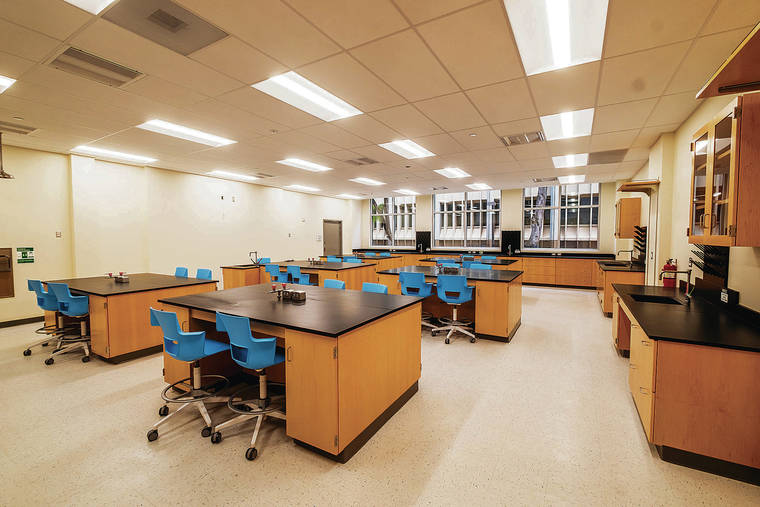The Life Sciences Building just completed at the University of Hawaii at Manoa will unite researchers, professors and students across disciplines in a thriving field where Hawaii has a natural edge, administrators say.
Life science is the study of all living things.
“Life sciences is one of the biggest majors on campus and still growing,” said Aloysius Helminck, dean of the College of Natural Sciences. “Hawaii is the best place to study life sciences because we have more biodiversity than anywhere in the world.”
PHOTOS: University of Hawaii to open new Life Sciences Building
“There are a lot of exciting things about this building,” he said in an interview. “Not only is it a state-of-the-art teaching and research facility; it focuses on genetics, genomics, microbiology and molecular biology. That is the direction a lot of research is going in and that students are really interested in. This building is designed with the idea of engaging students, post-docs and faculty together in research projects.”
The four-story, 45,000- square-foot building on East-West Road near Kennedy Theatre will be dedicated next month, but the Honolulu Star-Advertiser recently got a preview. The LEED-certified facility, with turquoise-accented windows and rooftop solar panels, will serve 1,000 students a week and house 23 faculty members and 60 graduate students.
“The research labs are designed in an open lab mentality where researchers share spaces,” Helminck said. “And there is a lot of collaborative space for students. … We are very grateful to the state Legislature that they enabled us to dramatically improve our science facilities.”
The building will house the newly merged School of Life Sciences, which encompasses biology, botany and microbiology, alongside researchers from the Pacific Biosciences Research Center, as well as the Biological Electron Microscope Facility.
“I think this is a great move to try to integrate programs and to integrate faculty across the campus,” said Margaret McFall-Ngai, who directs the Pacific Biosciences Research Center. “This gives us an opportunity to work together in ways that we’ve never been able to do before because we were so spread across campus.”
“It’s going to have great opportunities for undergraduates to get involved in research,” she said. ‘This is a phenomenal opportunity.”
Henke Hall was torn down to make way for the new Life Sciences building. Snyder Hall, which formerly housed science laboratories, is in such decrepit condition that it is also slated for demolition.
Several faculty from the Pacific Biosciences Research Center are moving into the new building. They are working on a $10.4 million grant from the National Institutes of Health Centers of Biomedical Research Excellence that explores links between environmental microbiomes and human health. Microbiomes are communities of microorganisms that live on and in people, animals, plants, soil, oceans and the atmosphere.
McFall-Ngai said that grant will bring “three major technological cores” into the Life Sciences Building.
“One is an imaging center that uses powerful microscopes,” she said. “The second is molecular biology and biochemistry of microbes. And the third is the insectory, where they breed and contain insects.”
“All three of those cores are meant specifically to share with everybody on the UH campus,” McFall-Ngai said.
Jan Gouveia, vice president for administration for the UH system, considers the Life Science Building symbolic of a new approach at the university.
“We stayed away from traditional thinking around programming of building space,” Gouveia said. “It’s a dynamic place where multiple disciplines get to do their research, do their instruction and have students collaborate and be the frontier of new leaders in Hawaii in both the research and academic arena.”
“That whole concept is reflected in that building,” she said. “It’s the way we are approaching our vision for the entire University of Hawaii.”
The project used the design-build method, which helps deliver projects efficiently with a single contract for design and construction at a fixed cost. The contract for $49.5 million was awarded to Layton Construction Co. and design consultant Group 70 International in January 2017. That price tag included the cost of demolishing Henke and Snyder halls.
The project was later expanded to add a PV solar system and upgrade the electrical, mechanical and hazardous exhaust system to provide more redundancy and efficiency, according to University of Hawaii spokesman Daniel Meisenzahl. That portion cost $10 million.
Another $5 million went to remove and mitigate chlordane found in the soil under Henke Hall once that building came down. The common termite treatment chemical was banned in 1988.
In all, the building cost $65 million, and it is expected to remove $19 million from the university’s deferred-maintenance backlog.
